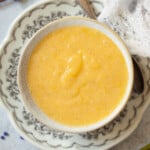Vegetarian lemon curd (lemon cheese)
This quick & simple recipe for vegetarian lemon curd is small-batch so it can be enjoyed even by the smallest of households. Great on toast. Sumptuous in sponge cakes. This lemon cheese is sunshine in a jar. Makes approx 200ml.
Servings: 10 servings (20ml)
Calories: 82kcal
Ingredients
- 1 Egg large, free-range
- 1 Lemon large
- 60 g Butter unsalted
- 75 g Caster sugar (see notes)
- 1 Vanilla pod (optional) or 1 teaspoon vanilla bean paste)
Instructions
- Crack the egg into a heavy based milk pan (or small saucepan) and beat.
- Grate the zest from the lemon finely and squeeze the juice from the lemon and add to the pan.
- Cube the butter and add to the pan, along with the sugar.
- Optional: if including vanilla, split the vanilla pod in half lengthways and add to the pan (chop in half if it's too long for your pan).
- Cook over low heat, whisk continuously using a small whisk until the mixture thickens – about 5-8 minutes. Do not let it boil - I use a food thermometer to keep an eye on the temperature and remove the pan from the heat when it reaches 85C/ 185F.
- Remove the pan from the heat and continue to whisk for a further minute. Remove the vanilla pod (if used) and scrape the seeds back into the pan. Whisk to mix the vanilla seeds in. (If using vanilla bean paste in place of the vanilla pod, whisk it in now).
- Optional: strain through a sieve to remove the lemon zest to achieve a smooth curd.
- Decant into a clean jar, let cool and then store in the fridge for up to 2 weeks.
Notes
- Always cook vegetarian lemon curd over a low heat as this reduces the risk of the liquid getting too hot, causing the egg to scramble.
- If the egg does begin to scramble, don’t panic. Just remove the pan from the heat, plunge the base of the pan into cold water and keep on stirring. This will help the curd to cool a little and halt the cooking. You’ll need to sieve the curd to remove the cooked pieces of egg, which will mean you’ll also remove the zest, but the curd will still be edible.
- Don’t forget to stir continuously.
- The curd should be cooked to a minimum of 70C/ 160F which is the temperature at which eggs are considered safe to eat. However, it can be cooked to 76C/ 180F before the eggs begin to scramble.
- Lemon cheese will get thicker as it cools, so don’t worry if it looks quite thin whilst cooking. By the time the temperature reaches 70-76C (160-170F), it should have the consistency of custard and be able to coat the back of a spoon.
- It’s up to you whether to remove the zest by straining the cooked curd through a sieve, depending on the texture you prefer.
Nutrition
Calories: 82kcal | Carbohydrates: 9g | Protein: 1g | Fat: 5g | Saturated Fat: 3g | Polyunsaturated Fat: 0.3g | Monounsaturated Fat: 1g | Trans Fat: 0.2g | Cholesterol: 29mg | Sodium: 45mg | Potassium: 23mg | Fiber: 0.3g | Sugar: 8g | Vitamin A: 176IU | Vitamin C: 6mg | Calcium: 7mg | Iron: 0.1mg
